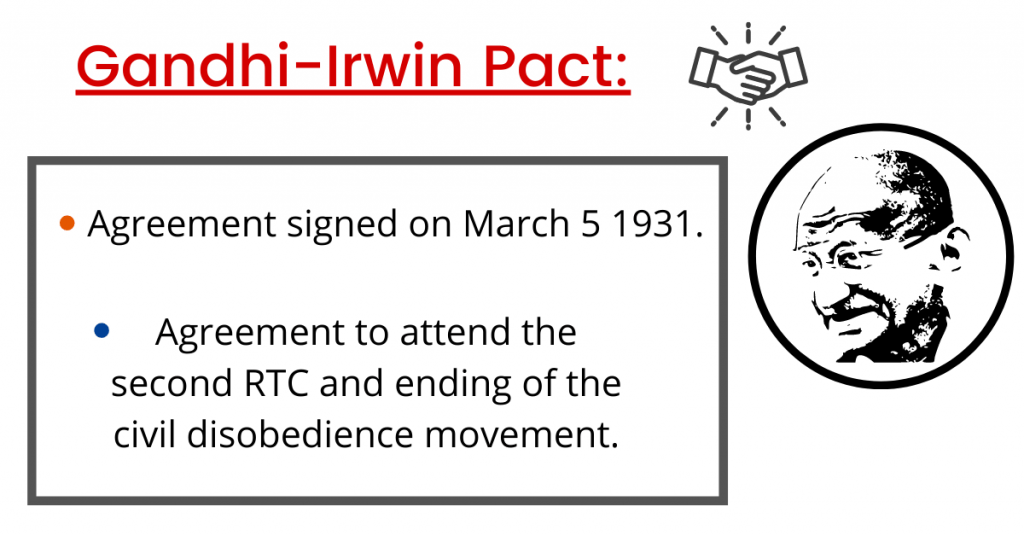The round table conferences were a series of meetings from 1930 to 1932 in three sessions. These were called by the British government to discuss the future constitutional plans of India.
The sessions were conducted on the advice of Muhammad Ali Jinnah to the Viceroy, Lord Irwin and Prime minister Ramsay MacDonald.
You should know that this was the time when the demand for self-rule (Swaraj) was increasing massively by the Indians and the lack of representation in the government was a key reason behind it.
Although many British politicians believed that India should move towards dominion status yet, there were serious disagreements between the British and the Indians.
The purpose of these conferences was to bridge the gaps between the two sides and discuss the future of the Indian subcontinent.
This was all about the introduction of this topic. Now, let’s discuss some other important details of this chapter without further introductions.
Reasons for the round table conferences:
- The Simon commission (a group of seven members of parliament) under the chairmanship of Sir John Simon disappointed the Indians.

This “all-white body” arrived in India in the later 1920s with the purpose of studying British constitutional reforms as a promise made in the Montagu-Chelmsford reforms (1919).
When this commission arrived in India (1927), it received massive criticism from the Indian politicians because it did not include any Indian (even though the purpose was to represent them).
When the commission published a two-volume report in May 1930, the first round table conference was convened to discuss this report. The report published by the Simon commission stated:
- The abolition of dyarchy and the establishment of a representative government in the provinces.
- Separate communal electorates to be retained.
- India should be given dominion status with complete internal self-government.
In short, the findings of this report were published in the form of a report which was to be discussed and the first round table conference provided the avenue for that.
- Due to the absence of the members of the Indian national congress (such as Gandhi), the first round table conference could not reach a practical solution.
This was because the Indian National Congress (INC) was an essential party of India and no decision could be reached without their consultation.
Since the majority of members of the Congress were imprisoned due to their non-cooperation movement, the British decided to assemble them for another conference.
How did they do that?
Well, the Gandhi-Irwin pact was signed.
Gandhi-Irwin Pact:
This was an agreement signed on March 5, 1931, between Gandhi (leader of the Indian nationalist movement) and Lord Irwin (British Viceroy)
With this pact, the civil disobedience (movement) in India ended. Moreover, Gandhi and other Congress members were also released from prison.

It was also agreed that Gandhi would attend the second round table conference and the tax on salt was also removed. Some other points of this agreement were:
- Discontinuation of salt march (by the Indian National Congress).
- The ordinances were withdrawn by the government of India.
- The ban over Congress was lifted and the confiscated properties were restored.
Due to this pact, it was ensured that the Congress attended the second round table conference and thus, this second session was conducted in 1931.
- The second round table conference increased the hostility between the Muslims and Hindus which led to the failure of the second round table conference.
As a result, it was vital to conduct the third round table conference because the new government in Britain threatened to impose their own solution to the problem if these discussions failed.
The British in the past came up with reforms, such as the Morley-Minto reforms (1909). However, these did not fulfil the demand of the Indians and they rejected them.
This created a situation of disorder and chaos in the Indian subcontinent and it was vital for both communities to sit together and discuss the future of India.
Therefore, these conferences seemed to be the only practical solution to the problems of India.
- Lastly, the British wanted to prevent any adventure such as the First War of Independence (1857).
One of the main reason behind this uprising was that the British were unaware of the Indian demands. They wanted to connect to the Indian politicians to prevent any uprising in the future.
Both sides presented their views on how India should be governed in the future through these meetings. These were some of the reasons behind these three sessions.
Now, let’s take a look at each of these sessions in a bit more detail now.
First round table conference:
The first session was conducted from 12th November 1930 to 19th January 1931. It was inaugurated by George V in the House of Lords in London.

This conference had 73 representatives from all parties and states of India, except the Indian National Congress, because of its civil disobedience movement against the British.
Lord Irwin’s controversial statement that India should be granted dominion status was opposed by multiple British politicians.
The first six meetings were fully attended where the delegates discussed their issues such as the federal structure. As a result, the British agreed that the representative government should be introduced on a provincial level.
Some other achievements of this meeting were:
- The insistence on parliamentarianism (acceptance of the federal principle, including the dominion status).
- The right of separate electorates for minority communities.
- The support of princes to the federal structure.
From the conservative party, Earl Peel and Oliver Stanley also attended this conference along with Indian state representatives such as the ruler of Jammu and Kashmir.
Further reading:
Khilafat movement | GCE O Level notes
Reforms of Ayub Khan (1958-1969)
Sir Aga Khan, Muhammad Ali Jinnah and Maulana Muhammad Ali Jauhar were some of the representatives from the Muslim league who presented the Muslim demands.
Note: This meeting was only limited to discussions and agreements but no solution was implemented because of the absence of the largest party of India (Congress).
Due to this, another meeting was convened which is known as the second round table conference.
Second round table conference:
This conference was conducted from September 1931 to December 1931 and a settlement between Gandhi and Irwin paved the way for Congress in this meeting.
This was the time when the Prime minister was running a coalition government with the Conservative party and therefore, they tried their utmost to reach a decision in this meeting.
In this meeting, Gandhi insisted that Congress was the main part for all Indians and it represented their demands. However, Jinnah was not willing to accept this because he reminded Gandhi that he was the spokesman of Hindus only.
Muhammad Ali Jinnah further added that the Muslims league had the right to represent the Muslims of India. Due to these differences, a deadlock was achieved between the two.
Moreover, there were serious differences over the right of seperate electorates for the minority communities. This is because Gandhi believed that religious protection was enough and the demand for separate electorates was unnecessary.

Jinnah rejected this ideology of Gandhi due to which no practical solution could be reached and the discussions over the constitution were in vain.
In short, the meeting failed to reach an agreement either communally or constitutionally because of the following demands of Gandhi:
- The establishment of a reasonable government (at the central and provincial level).
- The untouchables were Hindus but not “minorities”.
- Congress represented the entire India.
- There were to be no separate electorates (or special protection) for Muslims and other minority communities.
Due to the failure of this conference, another meeting was conducted which is known as the third round table conference.
Third round table conference:
This session (17th November 1932 to 24 December 1932) was only attended by forty delegates.
This was because the Congress and the British Labour party were absent which made it shorter and is considered less significant in the history of the Indian subcontinent.
A fascinating fact over here is that Jinnah was not even invited to this meeting, but some other Muslim league leaders were present at the conference.
However, the princes represented the Indian princely states but not much was achieved in this session. The biggest success of this event is that it happened despite all odds.
The recommendations of this session were published as a White Paper (1933). After discussing in the British parliament, the Government of India act of 1935 was passed on its basis.
Communal awards (1932):
The first two sessions achieved very little and the communal violence in India was enhancing. Therefore, the British introduced their own formula to this problem which is known as the communal award.
It was a unilateral attempt by the British Prime Minister, Ramsay MacDonald, to resolve Indian conflicts based upon their communal interests.
This award retained separate electorates for the minority communities such as the Muslims and this was extended to other communities such as:
- Sikhs.
- Anglo-Indians.
- Indian Christians.
- Europeans.
- Many other distinct regional groups (such as Marathas of Bombay presidency).
The Indian National Congress rejected them because they were enraged when the British gave this right to the “untouchables” as well and they decided to launch massive protests (such as fast unto death) against this action.
Due to this, the separate electorates for the “untouchables” were withdrawn.
Although these awards were not completely in favour of the Indian Muslims, yet they accepted them to prevent further disagreements.
Importance:
These three round table conferences were important because they introduced the Indian demands to the British. Moreover, it was ensured that the British were aware of the demands of the different Indian communities before passing their next reforms.

Furthermore, these conferences proved vital for the Muslims because Gandhi’s ideology was known in the second session when he denied the right of seperate electorates to the Muslims.
At the same time, it was also shown that the Muslim League was the sole representative of the Muslims.
The Government of India act (1935) was passed on its basis which proved to be the last major legislation before Independence.
You should also know that these meetings paved way for the Pakistan movement as well because the Muslims realised that they could not work with the Hindus and were two separate communities.
This is what the two-nation theory suggested as well.
Conclusion:
With this, our topic about the round table conferences has come to an end. Thank you very much for reading and staying with me till the end.
I hope that all your queries have been answered and all the questions related to the topic have been addressed. The topics such as the causes, events and importance of this meeting are explained.
This is a very important event in the history of the Indian subcontinent, and therefore, it is significant from the paper point of view. Stay tuned for more.
